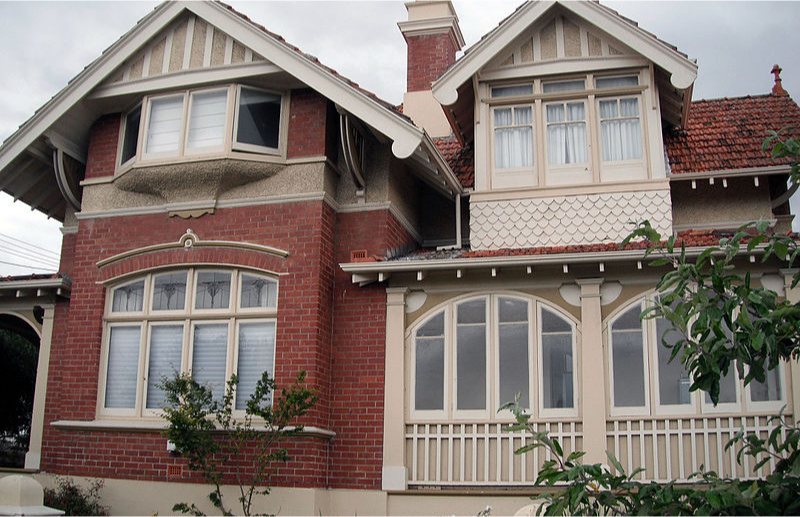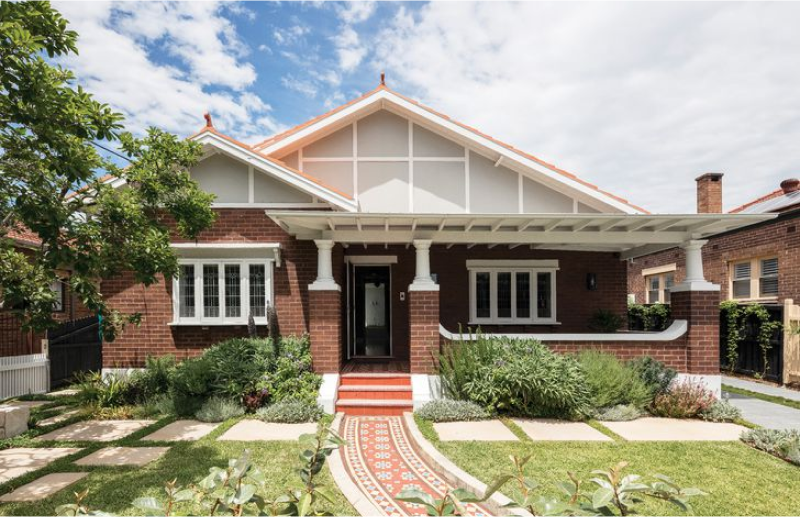EDWARDIAN (FEDERATION) ERA
1900-1918
EARLY EDWARDIAN
Circa 1804 > 1860
This period is also known as Federation and the houses from this time drew on both Victorian and Queen Anne features.
We often confuse Edwardian and Federation styles and that’s because they’re actually the same thing. ‘Edwardian’ refers to the English style of home that was popular at the time of Federation in Australia and named after King Edward (1901-1910).
A federation style home is now known as the Aussie adaptation of Edwardian architecture. One subtle difference is that the Federation style homes feature unique Australian motifs such as native flora, the rising sun, kangaroos and emus.
Edwardian or Federation homes are usually freestanding or semidetached, made of red brick or weatherboards carved to emulate stone, and feature rich stained and coloured glass in complex patterns and forms. They have beautiful bay windows, expansive and prominent return verandahs with tessellated tiles, finials, turned-timber posts and fretwork, a long central hallway, and a steep hipped tiled roof in slate or terracotta with detailed wooden fretwork in the front facing roof gables and windows.
Floor plans were generally like those of Victorian houses. Inside, they were adorned with pressed-metal ceilings, cornices, ceiling roses, architraves and timber skirtings. Many Victorian ornaments were still used, but houses were less ostentatious than the Victorian and Queen Anne styles.
The turn of the century saw a move away from the bold and muddy colours of the Victorian era to lighter shades of green, and cream with accents of oxide red or buff. Combining dark green and dark red trim became popular.

Social history
A land boom was born out of the extraordinary wealth created in the 19th century on the goldfields, and this was followed by the hardships of the 1890s Depression. These events crystallised the determination for a federated Australia, leading to Federation in 1901 with the formation of the Commonwealth Constitution, leading Australia into a modern 20th century with a fresh national identity. This encouraged a national confidence and the search for an Australian style. Australian flora and fauna became incorporated into building decoration and increasingly, architects attempted to design for the Australian climate.
The Federation style was undoubtedly inspired by a sense of Australian nationalism and identity, growing from a British colony to a federated country of the British Commonwealth.
Melbourne was temporarily Australia’s capital.
CALIFORNIA BUNGALOW
Circa 1860 > 1875
Australian bungalow designs are generally designed with influence from California, sometimes with Indian and British accents. Californian and Victorian climates are very similar, making the low, shady and solid style very popular.
These cosy looking homes were a blend of Arts and Crafts concepts with the ideal of the simple house in a natural Aussie setting.
California Bungalows share many similarities with Edwardian/Federation homes but what sets them apart are the signature thick columns supporting the front veranda. They are more rustic and feature an increased use of natural materials. Most were originally single storey and in Melbourne were mostly made from exposed dark brickwork mixed with roughcast render or weatherboard. They have low-pitched tiled roofs that often feature a dormer window and overlapped gables, a wide front veranda, and were set well back from the street. Inside, the ceilings are plain, and unlike previous styles, there were no servants quarters. Many bungalows have beautiful stained glass and decorative leadlight windows with rectangle or diamond panes, and intricate front doors. The wide entrance halls and flowing rooms with wood panelling and rough-cut walls have always embraced the Australian lifestyle and climate, hence their popularity.
There is an abundance of bungalows in and around Essendon. As trends change, the period features have stood the test of time. There are plenty of ways to freshen up and renovate these into timeless contemporary homes.

Social history
You guessed it, the California Bungalow was adopted from US designs at a time when American lifestyle and culture became a major influence on Australian society through film and music.
Embraced by speculative Melbourne builders, California Bungalows were the most popular style of new homes in the emerging Melbourne suburbs for the two decades leading up to the Depression. An increasingly relaxed lifestyle led to greater use of verandahs and the beginnings of open planning.